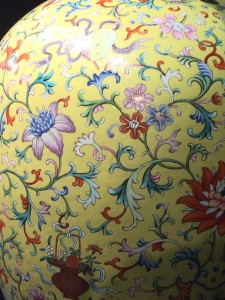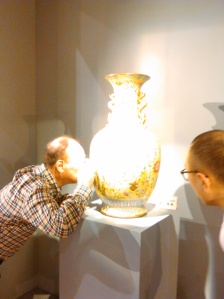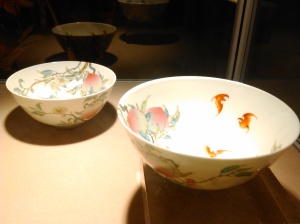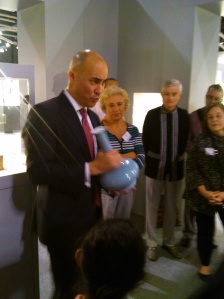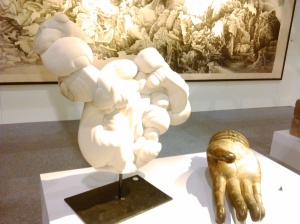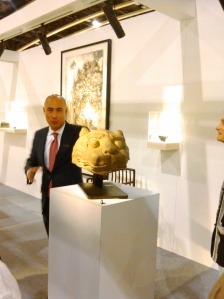You like Chinese Art?
You like Modern and Contemporary Paintings?
You enjoy Auctions?
Detail of the Qianlong Yellow-Ground monumental vase, picture@mathildeHK
Last Saturday, I went to the HKCEC to attend a private tour of Sotheby’s Asian Arts Department, with the Oriental Ceramic Society. As usual, Nicolas Chow gave us a very interesting tour of the ceramics highlights.
The monumental Pasini Yellow-Ground Sgraffiato vase, picture@sotheby’s
Chinese antics
We started with an enormous cloisonne vase from the Qianlong Period. I had never seen such a huge and exquisite piece. That Qianlong yellow vase was part of the Italian Pasini collection and came from the Royal Palace of Beijing. It appeared on the art market in the 1920 th. Recently, it was part of an aution sale in Florence. The expert judged necessary to ask Nicolas Chow about the piece. From the pictures sent by Florence, Nicolas estimated it around 6 million euros. It was indeed sold for 8 million euros. However, the Chinese buyer disappeared after the sale. I understood Nicolas bought it on Sotheby’s behalf after the sale. It was dark and dirty. Nicolas Chow explained us it took 2 interns and 1 month to clean it.
Catalogue descritption:
The OCS amateurs and the Yellow vase, picture@mathildeHK
“The massive vase mightily constructed with an ovoid body sweeping up to a waisted neck and flared rim, the exterior luxuriantly decorated in the famille-rose palette with large stylised flower heads, including lotus, iris and honeysuckle, all wreathed by feathery foliate scrolls, a cluster of peaches issuing from one large bloom in the centre, the floral blooms interspersed with beribonned anbaxian emblems, including a double-gourd, a fan, a sword and a basket of flowers, all above an upright elongated ruyi-shaped lappet border encircling the base, the neck decorated on both sides with a stylised floral bloom suspending a chime with a double-fish and a tasselled wan symbol attached to it, the neck flanked by a pair of scroll handles in the form of a stylised dragon, all between three bands of various petal lappet bands encircling the rim, base and splayed foot respectively, the footrim bordered with an iron-red ‘classic scroll’ band, the opulent design delicately picked out in white and shaded tones of rose-pink, blue, green and red and reserved on a ground of brilliant lemon-yellow ground finely engraved with dense sgraffiato feathery arabesques, the interior and base enamelled turquoise, the base inscribed in iron-red with a six-character seal mark within a white cartouche.“
A Pair Of Famille-Rose ‘Peach’ Bowls Marks and Period Of Yongzheng 14.3 cm Est. HK$40 – 60 million / US$5.1 – 7.7 million, picture@sotheby’s
Nicolas Chow also showed us his exhibition called Yongzheng – Treasures from the Age of Harmony and Integrity.
“That unprecedented theme sale consists of a highly selective group of porcelains and works of art, the many of which are unique, from the Yongzheng reign, the apex of quality in the Qing dynasty. The highlight of the auction is a jade seal with its original box, one of only five recorded jade examples from the reign and the greatest example in private hands.”
Imperial Pale Celadon Jade ‘Yongzheng Yubi Zhi Bao’ Seal with original Ivory-Inlaid Box and Cover The seal: Qing Dynasty, Kangxi Period The seal face: Qing Dynasty, Yongzheng Period Seal 7.5 x 6.1 x 6.1 cm Box and cover 9.1 x 9.1 x 8.6 cm Est. HK$30 – 40 million / US$3.8 – 5.1 million, picture@sotheby’s
I was impressed by the Yongzhen period seal. The Yongzheng period lasted for 13 years. It was then difficult to find pieces clearly identified as such. There are only 5 seals listed in the imperial collections carved in pure jade. That one came with its original box. According to Nicolas, both the seal and the box were for Emperor Kangxi but modified by Yongzhen. It was even carved by him. The estimated price was 30 million HKD for it. Nicolas explained how Chinese new collectors would fight to acquire it.
The Yongzheng family rose porcelain bowls with peaches were very nice as well. Only 4 pairs are known in the World. What I found very nice was the presentation of a blue vase which was originally part of Nicolas Chow’s grand mother collection. Nicolas explained us he remembered playing in the room the vase was on display and being very happy to offer it for the sale, see the picture below.
Chinese contemporary
Then, Nicolas Chow showed us the section dedicated to Chinese Cabinet and curio artifacts, a category I had already discovered at Sotheby’s a year ago. That amazing mix of stones, furniture, rocks, fossils, ancient sculptures, contemporary calligraphy and ink on paper was really charming.
Picture@mathildeHK
That sale entitled Contemporary Literati showcased a beautiful collections of white stones I found very figurative, the Gogottes, such as the A ‘MADONNA AND CHILD’ GOGOTTE, OLIGOCENE (30 MILLION YEARS OLD) or A GOGOTTE OLIGOCENE (THIRTY MILLION YEARS OLD), FONTAINEBLEAU, FRANCE
Catalogue :
“This gogotte formation, which could unknowingly be a contemporary sculpture if not for its age of millions of years, is composed of tiny grains of quartz forged together with calcium carbonate (sandstone). These formations, or concretions, developed over time through the swirling of heated water emerging through crevices into a basin of extremely fine white sand. Each unique and otherworldly, these strange forms capture the imagination.
Gogotte concretions can be found in natural history museums around the world. A particularly well-preserved example is on display at Smithsonian Institution National Museum of Natural History illustrated at http://www.mccullagh.org/image/10d-5/sandstone-concretion.html.”
A GREY LIMESTONE HEAD OF A LION
NORTHERN QI DYNASTY, 6TH / 7TH CENTURY, picture@mathildeHK
Sotheby’s Spring sales 2015 – 4 -7 AprilHong Kong
Hong Kong Convention and exhibition center – Harbor Road
